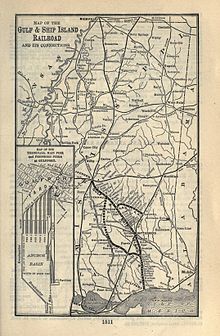Gulf and Ship Island Railroad
| Overview | |
|---|---|
| Headquarters | standard gauge |
| Length | 308 miles (496 km)[2] |

The Gulf and Ship Island Railroad (G&SI) was constructed in the state of
Railroad charter
The Gulf and Ship Island Railroad (G&SIRR) was developed under three charters provided by the
William H. Hardy
In 1887, William H. Hardy accepted the presidency of the Gulf and Ship Island Railroad
Railroad construction begins
Until the end of 1888, construction on the G&SIRR was accomplished using prisoners contracted through the
Joseph T. Jones

By the late 1800s, Joseph T. Jones had made a fortune in oil wells and oil pipelines in Pennsylvania and West Virginia. He heard of the potential for investment in the bankrupt railroad being constructed in Mississippi that included 63,000 acres (25,000 hectares) of timberland, as well as another 400,000 acres (160,000 hectares) of timberland available for harvest.[6]
Jones, along with other investors, formed the Bradford Construction Company to buy the bankrupt railroad and pursue the investment opportunity in Mississippi. The longest section of the G&SIRR was completed by the Bradford Construction Company of Pennsylvania, under the leadership and financing of J.T. Jones. In 1901, Jones bought out his partners, and the Bradford Construction Company merged with the Gulf and Ship Island Railroad Company.[6] In need of a residence on the Gulf Coast, Jones had the Great Southern Hotel constructed at Gulfport. Nearby, a new office building was constructed for the Gulf and Ship Island Railroad Company.
Although the G&SIRR Company changed hands to Joseph T. Jones, W.H. Hardy remained involved as a board member until 1899. In 1895, Hardy was elected to the Mississippi State Legislature[7] which kept him at the State Capital in Jackson, precluding his involvement with the railroad.
Railroad location
On January 1, 1897, the railroad was completed between Gulfport and Hattiesburg.[2] Another 3.5 years passed before the railroad opened between Hattiesburg and Jackson (July 4, 1900).[2] The Gulf and Ship Island Railroad operated exclusively in the State of Mississippi. The company owned approximately 160 miles (260 km) of standard gauge main rail line, 147 miles (237 km) of branch lines and 106 miles (171 km) of track in Gulfport.[3] The primary rail line began at Gulfport and extended northward to Jackson, Mississippi, with branch lines connected to the towns of Maxie, Mendenhall, and Laurel. Additional rail lines extended to the towns of Pontotoc and Ripley and into territory adjacent to the Tennessee River in the northeastern portion of Mississippi.[3] The G&SIRR opened a vast resource of southern yellow pines for harvest. Logging and lumber companies sprang up in towns along the rail line and used the railroad to transport logs to sawmills and lumber to markets. By 1902, the 74 miles (119 km) of G&SIRR, between Gulfport and Hattiesburg, averaged one sawmill and one turpentine distillery every 3 miles (4.8 km). In 1907 alone, about 800 million board feet of southern yellow pine lumber was transported on the G&SIRR.[8]
Exports and imports
The G&SIRR Company controlled a 6-mile (9.7-km) long channel in the Gulf of Mexico that connected the mainland to Ship Island. Dredging of a shipping channel was completed by the S.S. Bullis Company in 1902; it connected Ship Island and the main railroad terminal at Gulfport.[3] The G&SIRR greatly facilitated the development of the shipping port. Between 1903 and 1907, more than a billion board feet of timber was shipped out of Gulfport. In 1908, the first shipment of cotton was exported by steamship. During the early years after port development, some of the items imported through Gulfport included phosphates, iron pyrite, creosote oil, naval stores and mahogany. From 1910 through 1913, the Port of Gulfport shipped and exported more timber than any other port in the world.[6]
The state of Mississippi derived substantial benefits from the G&SIRR. The railroad facilitated the development of towns along its route, gave rise to a booming timber industry, resulted in the creation of the city of Gulfport, and brought about construction of a deep-water seaport. Beginning in 1924, the G&SIRR operated as a subsidiary of the Illinois Central Railroad but lost its independent identity in 1946.[9]
See also
- Wiggins Depot (Mississippi): a G&SI station
- Finkbine-Guild Lumber Company
References
- ^ Railroad company abbreviations (reporting marks, carrier alpha codes) as used in the CTA Railroad Network for carriers, operators, and track owners Retrieved 2017-01-07.
- ^ a b c d Mississippi Rails: Gulf and Ship Island Railroad Retrieved 2014-04-27
- ^ a b c d e f "Gulf and Ship Island Minute Book, 1887-1907". Archived from the original on 2010-06-04. Retrieved 2010-12-01.
- ^ a b "National Register of Historic Places Registration Form|Gulfport Harbor Square Commercial Historic District" (PDF). mdah.ms.gov. September 12, 2011. Retrieved 2022-05-22.
- ^ Biennial Reports of the Departments and Benevolent Institutions of the State of Mississippi for the Years 1896-97. Jackson, Mississippi: Clarion-Ledger Co. 1898. pp. 34–36.
- ^ a b c J.T. Jones—Early Oil Region Producer Retrieved 2014-04-27 Archived 2014-04-27 at the Wayback Machine
- ^ "The University of Southern Mississippi – McCain Library and Archives|Hardy (William H. and Sallie J.) Papers". lib.usm.edu. Retrieved 2022-05-22.
- ^ Fickle, James E. 2001. Mississippi Forests and Forestry. University Press of Mississippi. 347 pages.
- ^ Gulf & Ship Island Railroad Index Archived 2011-01-07 at the Wayback Machine


